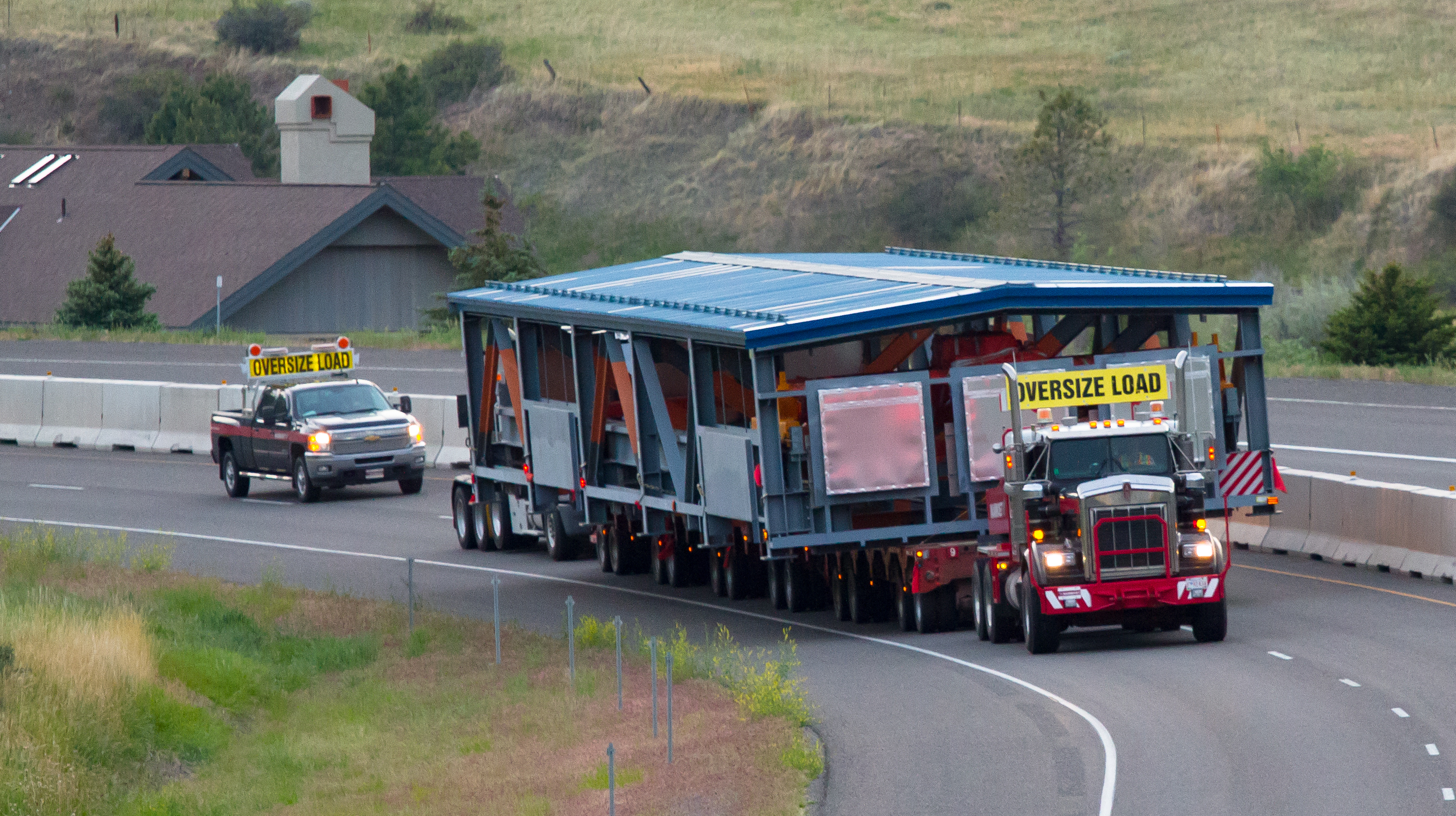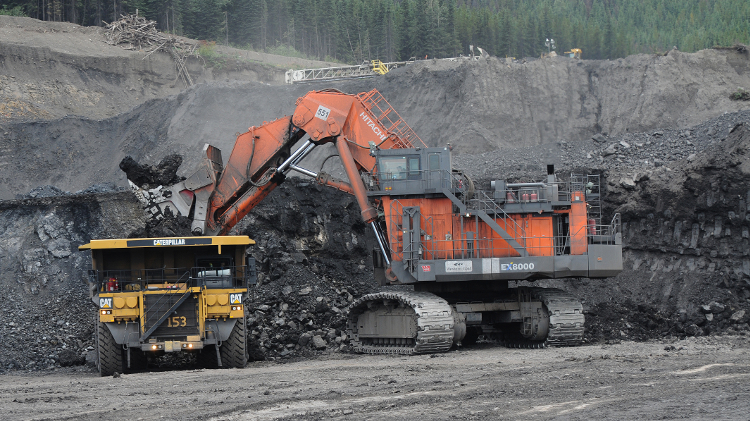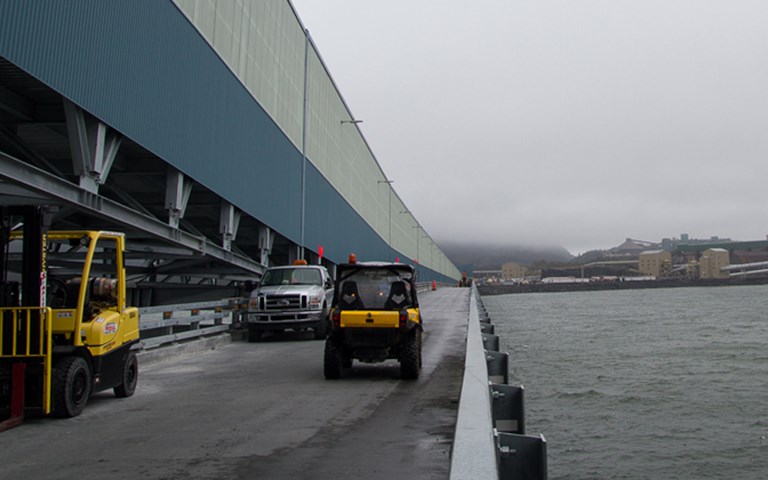When the new wharf is completed this summer, the Port of Sept-Îles will have a total capacity of 90 million tonnes per year. Valerian Mazataud
Bolstered by 60 years of experience in iron ore shipping, the Port of Sept-Îles took advantage of the last commodity boom to convince various public and private partners to embark on an ambitious project: the building of a brand-new multiuser wharf with a 50- million-tonne capacity. Upon completion this summer, the port’s total capacity will reach 90 million tonnes, making it the largest ore-shipping port in North America and the second largest commodity port in Canada, after Vancouver.
During a September site visit, the air on the opposite side of the 10-kilometre-wide Bay of Sept-Îles was so still that it was difficult to imagine the most important harbour project in Canada was being built nearby. When approaching Pointe- Noire though, on the west end of the bay, the gigantic Lshaped pier, which extends 600 metres into the bay before connecting to a 400-metre-long wharf, dominates the landscape. “There is a reason why the very first iron ore companies chose the Bay of Sept-Îles to ship their ore, in the 1940s and 1950s,” says Port CEO Pierre Gagnon. “They realized that it had the capacity to support all of the inland potential.”
Two state-of-the-art Sandvik conveyor belts overhanging the structure will each soon carry no less than 8,000 tonnes of ore per hour to their respective loaders. The wharf will have the capacity to receive one ship on each side and to load them simultaneously with any kind of ore. “Our infrastructure was designed with the flexibility to load direct shipping ore, fines or pellets,” says Gagnon. Finally, the Port has plans for a storage area with about 50 million tonnes of capacity within two kilometres of the wharf.
Unlike the other piers in the bay, the multiuser wharf is deep enough to welcome 400-tonne Chinamax-standard ships, which previously had to weigh anchor and wait for smaller ships to come and load them – a costly operation. “Shipping costs could go down by 20 to 40 per cent depending on the size of the vessels,” says Gagnon. Sept-Îles will be just the fourth wharf in the world with the ability to load Chinamax ships.
In order to ensure it was up to the construction challenge, the Port had to reach out to foreign expertise. “Our consultant gathered experts from Brazil and Australia around the table who already handle iron ore,” says Gagnon. “We had to design a world-class infrastructure from scratch.”
A unique financial package
In the wake of the spectacular rise in iron ore prices in the 2000s, dozens of projects were set up in the Labrador Trough, prompting the government of Quebec to launch its Plan Nord in 2011. The existing shipping infrastructure did not have enough capacity for up-and-coming companies to secure access to the global market. “Between 2005 and 2008 alone, eight companies reached out to us asking for an increase in capacity,” says Gagnon.
The growing pressure from the private sector convinced the Port to apply for federal funding. The initial down payment needed to launch the project amounted to 25 per cent of the estimated $220 million total capital cost. “It would have been too bad to see the federal government deprived of billions in investment just because the needed infrastructures were not in place when companies were willing to invest,” says Russel Tremblay, communication and marketing director at Economic Development Sept-Îles.
However, the public sector would not take on all of the capital cost, while no mining company had enough planned output to justify the investment by itself. In the end, the federal government and the Port each took on 25 per cent of the capital cost, while five private partners joined in and assumed the remaining 50 per cent – each of their contributions being proportional to their output – for a total private financing of $110 million. These five companies thus got a foothold in the port, securing a total shipping capacity of 43 million tonnes per year. Among these, Alderon Iron Ore has eight million tonnes, New Millenium Iron 15 million tonnes, Champion Iron 10 million tonnes, and Labrador Iron Mines and Tata Steel five million tonnes. Since the total shipping capacity of 50 million tonnes may expand to 60, the remaining capacity could either be offered to additional partners, or be sold on the spot market.
By contributing to the financing, these private users will benefit from competitive rates. “Our port is guaranteed,” explains Tayfun Eldem, CEO at Alderon. “We have contributed $20.5 million towards construction, as a buy-in payment. We will recover our initial capital injection when we start shipping because we will be getting a discount like the other users.”
A thorn in the side
Even though there is harmony between the seven partners, the same cannot be said of their relationship with Cliffs Natural Resources, the company next door. In order to ship ore through the port on Pointe-Noire, mining companies will need access to some of the neighbouring lands currently owned by Cliffs. However, the Port of Sept-Îles and Cliffs still have not agreed on the sale of these lands, and a lawsuit was filed by Cliffs against the Port in 2013, though nothing has come of it yet.
Parallel to the suit, the Port of Sept-Îles made a request to the Canadian Transportation Agency (CTA) last spring to make Cliffs’ railway in Pointe-Noire a “common carrier” similar to the Quebec North Shore & Labrador Railway, which the Iron Ore Company of Canada must share with other companies operating in the Labrador Trough. Cliffs’ railway is the only connection between Pointe-Noire and the broader rail network. The Port’s request was dismissed by the CTA last October.
Both disputes have slowed down the financing of some of the projects in the Labrador Trough, which rely on having access to the port, according to Tremblay. “The whole Quebec economy is affected by this litigation,” he says. “No other region in the province is expecting billions in investment.” There is confidence, though, that a resolution is within reach. The government of Quebec intervened in June and is currently looking at a number of possible scenarios. Cliffs’ recent decision to close its Bloom Lake mine and its plan to sell off its Canadian assets could speed things up, Tremblay points out. “We are expecting transactions in the near future,” he says, hinting that Cliffs’ railway could change ownership if it were to sell its Wabush Mines assets.
These legal hurdles do not prevent Gagnon from looking towards the future with optimism. “Depending on how the iron ore market evolves, the wharf might well be just a first phase,” he says. If Adriana Iron Ore, which is advancing the large Otelnuk Lake project, joins the partners in funding the second phase, it would see the main wharf expanded into a large T. “We already have plans and specifications to copy-paste another 100-million-tonne wharf,” says Gagnon. “There is still room in the bay and it can support all of the potential in the Trough, both in Quebec and Labrador.”




